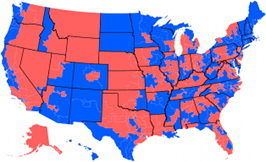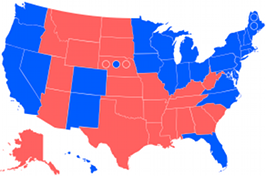Be jealous no more of those Brits with their fancy Swingometers. Now we too have one! Of course, the idea of a uniform national swing makes no more sense here than it did over there, but it can still be fun to play around with. So enjoy the 2010 Swingometer for the US House, for whatever it’s worth.
P.S. It takes a 15.1 swing toward Republicans to change control of the House.
The Swingometer uses Javascript and SVG, and is only tested so far in Firefox, Safari, Safari Mobile, and Google Chrome. MS Internet Explorer probably can’t handle it. Opera might. Blackberry users are sent my condolences. Please feel free to hit the Contact form or leave a comment here with bug or success reports.



 House of Representatives Swingometer
House of Representatives Swingometer Electoral College Swingometer
Electoral College Swingometer
That does not seem right to me, at all, that it takes a 15% swing to win back the House.
Nationally, the Congressional vote in 2008 was 53.2%D/42.5%R. So only a +7.5%R swing would get the GOP to 50% of the vote and, historically, the GOP has been able to take or hold the House with as little as 48-49% of the national Congressional vote.
So I’m thinking there’s a systematic error in there somewhere, if it’s telling you that you need *double* the percentage swing that you should need to actually take back the House. Is your swingometer based on just the 2008 national results? – That could be part of the problem right there…
Yeah, it’s not wrong to use the 2008 results. 2008 *happened*, like it or not!
I’ll look at it again though.
Freaking raw data was wrong based on what I just found. Digging in further…
False alarm. The raw data looks right.
Note that this is *two-way* margin between Ds and Rs, seat by seat, which is how the BBC does their swingometers thanks to their active three-way party battle.
Maybe that’s throwing you off.
I guess that would explain why it’s exactly double what I calculate the ‘swing’ to be.
That said, I guess I don’t like the way the British do it – to my thinking, a ‘swing’ should only be done in terms of the ‘swing’ “for” or “against” a party, not the “swing” from one party to the other party! The latter seems like “double-counting” to me!
Anyway, thanks for the explanation…